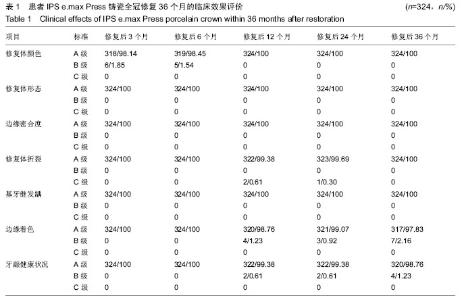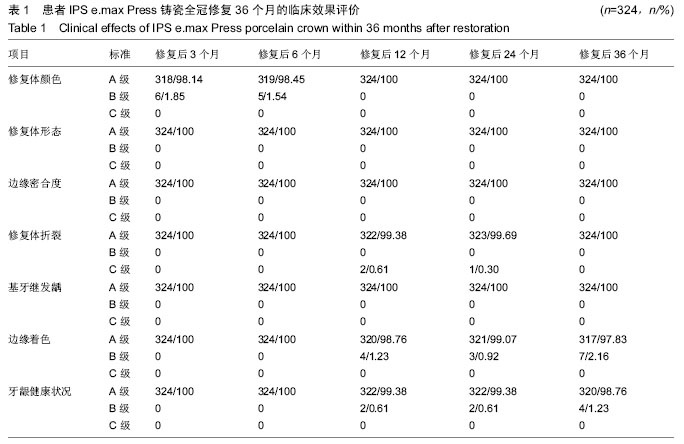| [1] Anusavice KJ.Degradability of dental ceramics. Adv Dent Res.1992;6:82-89.[2] Anusavice K.Phillips' Science of Dental Materials. Eleventh Edition.W.B.SaundersCompany Philadelphia; 2003.[3] Ralgrodskl AJ.Contemporary all-ceramic fixed partial dentures: A revivew. Dent Clin North Am. 2004;48: 531-544.[4] Touatl B.Innovative dental ceramics: Expanding the material alternatives. Pract Proced Aesthet Dent. 2005; 17:357-358.[5] Scherrer SS,De Rijk WG,Wiskott HW,et al.Incidence of fractures and lifetime predictions of all-ceramic crown systems using censored data.Am J Dent. 2001;14: 72-80. [6] Fradeani M,Redemagi M.An 11-years clinical evaluation of leucite-reinforced glass-ceramic crowns:A retrospective study.Quintessence Int. 2002;33:503-510.[7] Blatz MB.Long-term cilinical success of all-ceramic posterior.Quintessence Int. 2002;33:415-426.[8] Della Bona A,Kelly JR.The cinical success of all-ceramic restorations.J Am Dent Assoc. 2008;139 (suppl):8S-13S. [9] Beier US,Kapferer I,Dumfahrt H.Clinical long-term evaluation and failure characteristics of 1,335 all-ceramic restorations.Int J Prothodont. 2012;25: 70-78.[10] Vult von Steyem P.All-ceramic fixed partial dentures. study on almumium oxide and zirconium dioxide-based ceramic systems.Swed Dent J Suppl. 2005;173:1-69.[11] Palls K,Griggs JA,Woody RD,et al.Fracture resistance of three all-ceramic restorative systems for posterior applications.J Prosthet Dent.2004;91:561-569.[12] Kelly JR.Clinically relevant approach to failure testing of all-ceramic restorations.J Prosthet Dent. 1999;81: 652-661.[13] Zhao K,Wei YR,Pan Y,et al.Influence of veneer and cyclic loading on failure behavior of lithium disilicate glass-ceramic molar crowns.Dent Mater. 2014;30:164-171.[14] Dhima M,Assad DA,Volz JE,et al.Evaluation of fracture resistance in aqueous environment of four restorative systems for posterior applications.Part 1.J Prosthodont. 2013;22:256-260.[15] Dhima M,Carr AB,Salinas TJ,et al.Evaluation of fracture resistance in aqueous environment under dynamic loading of lithium disilicate restorative systems for posterior applications.Part 2.J Prosthodont. 2014;23:353-357.[16] Simeone P,Gracis S .Eleven-Year retrospective survival study of 275 veneered lithium disilicate single crowns.Quintessence Int.2015;35:685-693.[17] Albakry M,Guazzato M,Swain MV.Biaxial flexural strength,elastic moduli,and x-ray diffraction characterization of three pressable all-ceramic marerials. J Prosthet Dent. 2003;89:374-380.[18] Gracis S,Thompson VP,Ferencz JL,et al.A new classification system for all-ceramic and ceramic-like restorative materials.Int J Prosthodont. 2015;28: 227-235.[19] Pieger S,Salman A,Bidra AS.Clinical outcomes of lithium disilicate single crowns and partial fixed dental prostheses: a systematic review J Pros Dent. 2014; 112:22-30.[20] 唐雄飞,孙振学,王晓颖,等.IPS e.max Press 铸瓷全冠修复前后龈沟液中IFN -γ、TNF-α、MMP-2 的测定及其临床意义[J].武警医学杂志,2013,24(10):895-897.[21] Gresnigt M,Ozcan M,Kalk W.Esthetic rehabilitation of worn anterior teeth with thin porcelain laminate veneers. Eur J Esthet Dent.2011;6:298-313.[22] Atali PY,Cakmakcioglu O,Topbasi B,et al.IPS Empress onlay luted with two dual-cured resin cements for endodontically treated teeth:A 3-year clinical evaluation. Int J Prosthodont.2011;24:40-42.[23] Cubas GB,Habekost L,Camacho GB,et al.Fracture resistence of premolars restores with innlay and onlay ceramic restoritions and luted with two different agents. J Prosthodont Res.2011;55:53-59.[24] Madan N,Pannu K.Restorration of maxillary anterior esthtics using lava all-ceramic fixed dental protheses. Int J Comput Dent.2011;14:47-53.[25] Wolfart S,Eschbach S,Scherrer S,et al.Clinical out-come of three-unit lithium-disilicate glass-ceramic fixed dental prostheses: up to 8 years results.Dent Mater.2009;25:e63-e71.[26] Etman MK,Woolford MJ.Three-year clinical evaluation of two ceramic crown systems: a preliminary study.J Prosthet Dent.2010;103:80-90.[27] 赵铱民.口腔修复学[M].北京:人民卫生出版社, 2014: 96-101.[28] Reltemeler B,Hansel K,Walter MH,et al.Effeect of posterior crow margin placement on ginggival health.J ProSthet Dent.2002;87:167-172.[29] Kussano CM,Bonfante G,Batista JG,et al.Evaluation of shear bond strength of composite to porcelain according to surface treatment.Braz Dent J. 2003; 14(2): 132-135.[30] Goodacre CJ,Campaghi WV,Aquilino SA.Tooth preparations forcomplete crowns;an art form based on scientific principles.J Prosthet Dent. 2011;83(4): 363-376.[31] Fasbinder DJ,Dennison JB,Heys D,et al. A clinical evaluation of chairside lithium disilicate CAD/CAM crowns: a two -year report.J Am Dent Assoc. 2010; 141(Suppl 2): 10S-14S.[32] Schaefer O,Watts DC,Sigusch BW,et al.Marginal and internal fit of pressed lithium disilicate partial crowns in vitro: a three-dimensional analysis of accuracy and reproducibility.Dent Mater.2012,28(3):320-326.[33] Erakat MS,Chuang SK,Yoo RH,et al.Immediate loading of splinted locking-taper im plants:1-year survival estim ates and risk factors for failure.Int J O ral Maxillofac Implants.2008;23(1):105-110.[34] Fishel DL,Vanarsdall RL Jr.The use of miniscrews for orthodontic anchorage. Com pend Contin Educ Dent. 2007;28(12):638-642.[35] Stanley HR.Biological evaluation of dental material.Int Dent J.1992;42:37-54.[36] Gemalmaz D,Ergin S.Clinical evaluation of all-ceramic crowns.J Prosthet Dent.2012;87(2):189-196.[37] 孟焕新.牙周病学[M].北京:人民卫生出版社, 2014: 210-211.[38] Clelland NL,Ramirez A,Katsube N,et al.Influence of bond quality on failure load of leucite-and lithia disilicate -based ceramics.J Prosthet Dent. 2007;97(1): 18-24.[39] 屈直,金鼎,于晋,等.铸瓷髓腔固位冠对短冠磨牙修复效果的临床观察[J].中国医科大学学报,2014,43(4):376-378.[40] Albert FE,EL-Mowafy OM.Marginal adaptation and microleakage of procera all ceram crowns with four cements.Int J Prosthodont.2004;17(6):529-535. |

